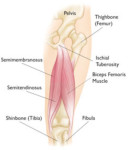Pulled hamstring is a common hamstring muscle injury among athletes, especially those who engage in sporting activities that involve sprinting like basketball, soccer and track. A pulled hamstring, also referred to as a strain, is used in reference to injuries that affect any of the muscles located on the rear of the thigh. Athletes who experience hamstring injuries often recover after treatments that employ simple non-surgical procedures.
Anatomy

The hamstring muscles run down the back of the thigh. There are three hamstring muscles:
- Semitendinosus
- Semimembranosus
- Biceps femoris
These muscles extend downwards from the ischial tuberosity, which is a point at the bottom of the pelvis, and continue past the knee joint towards the lower leg, where they end. The three muscles work jointly to assist in the back and forth motion of the leg with the knee serving as a fulcrum. This implies that the hamstring muscles enable you to bend your knee or extend your leg to assume a straight position.
Description

Hamstring muscles suffer the same injuries as other muscles in the body, including partial tears, complete tears and muscle pulls. Muscle strains fall into different categories depending on the degree of severity, with the lowest level, grade 1, describing mild muscle injuries that often recover rapidly. As the level increases, so does the degree of severity of the injury, such that grade 3 signifies a complete muscle tear that may require several months to recover.
The majority of hamstring muscle injuries affect the dense section of the muscle, where the muscle and tendon fibers join. Severe hamstring injuries result from extreme tears whereby the tendon separates completely from the bone, at times pulling a portion of the bone with it. This kind of severe injury is referred to as an avulsion injury.
Cause
Muscle Overload
Most hamstring muscle injuries result from overloading the muscle. This can result from applying a sudden load on the muscle, or stretching it beyond its capacity, causing it to strain. The process takes place when the hamstring muscles stretch and contract at the same time. This sounds like a contradictory statement, but such situations arise when you extend the muscle while it is loaded, leading to an eccentric contraction.
Eccentric contraction of the hamstring muscles is a common occurrence during sprinting. It happens when the rear of the leg is straightened as you push forward using your toes to take off. At this point of a stride, the hamstring muscles are both extended and loaded due to the weight of the body and the force applied at the foot or toes to initiate forward motion.
Large and sudden loads are also likely to result in hamstring tendon avulsions.
Risk Factors
Several factors can make it more likely you will have a muscle strain, including:
- Tight muscles: muscle tightness is a primary cause of strain. As such, athletes should follow regular year-round programs that involve daily stretching and other exercises.
- Imbalance of muscle groups: this occurs when two opposing muscles have varied levels of strength, as is the case with thigh muscles. The quadriceps muscles located on the front thigh are often more powerful than the hamstring muscles at the back. This imbalance causes the quadriceps to endure high-speed activities longer than the hamstring muscles. The early fatigue of hamstring muscles is a likely cause of strain.
- Poor muscle conditioning: this refers to a situation whereby your muscles are weak and incapable of handling the stress of exercising, leading to increased risk of injury.
- Muscle fatigue: fatigue diminishes the capacity of muscles to absorb energy, which increases their susceptibility to injury.
- Choice of muscle engaging activity: the risk factors mentioned above can happen to anyone, but there are groups of people who are more likely to encounter them and end up with a hamstring strain. These include:
- Dancers
- Athletes such as runners and sprinters
- Sports men and women like football, soccer and basketball players
- Adolescent athletes whose muscles are still in early stages of development
- Older athletes who have reduced the intensity of their exercise routine
Adolescents are susceptible to hamstring strains due to growth spurts that cause their bones to develop faster than muscles. This causes the bones to extend the muscles, and any sudden and impactful activity can cause the muscle to tear.
Symptoms
The most obvious sign of a hamstring during the course of your activities is the sudden, piercing pain on the back side of your thigh. It is likely to force you to a sudden halt, and cause you to lie down. Other signs of a hamstring strain are;
Additional symptoms may include:
- Swelling after a short while following an injury
- Discoloration at on the hind side of your leg at a point below the knee – usually after a few days
- Persistent frailty in your hamstring – can go on for weeks
Most cases of muscle tear treatment can be healed with nonsurgical. For severe cases, surgery may be needed.
Looking For A Reliable Knee Orthopaedic Specialist?
Fast Medical Attention, Transparent Fees
Make an appointment for comprehensive care for your knee problems!
